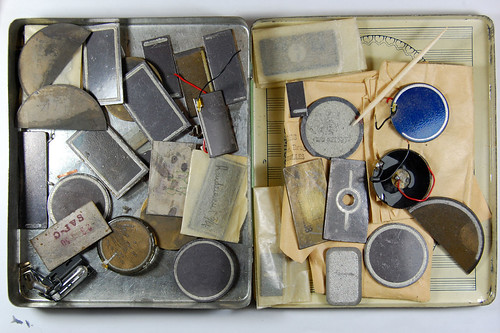Selenium

|
| Selenium Cells image by Hans Kerensky (Image rights) |
Selenium is element 34 in the periodic table, It is a non-metal with highly photovoltaic and photoconductive material, that was used extensively in light-metering devices before the 1970s. This was the first practical exposure meter, introduced by Rhamstine and Weston in the early 1930s. The Selenium sensor consists of an iron plate with one side covered with selenium, and then an ultra-fine layer of gold over that. When the gold layer is exposed to light, an electric current flows between that and the iron side, which can be measured by an ammeter. The current generated is directly proportional to the amount of light that hits the sensor. This has several advantages, such as not needing batteries and being sensitive to the visible spectrum in similar ways to BW film. However, Selenium light meters have a tendency to lose effectiveness over time as the selenium would "die out" from exposure to light and heat.
They were replaced by the 1970s with CdS (Cadmium-Sulfide) and later Silicon meters in the '80s, these are smaller, more accurate, and have better longevity. However, these cells are photo-resistors and require battery power.
Another photographic use for selenium is the toning of black and white prints. Selenium toning offers both the artistic use of intensifying and extending the tonal range of black and white photos, as well as the archival advantage of increasing the permanence of images.
Selenium is a necessary micronutrient in human health, however it is also considered to be toxic. High blood levels of selenium (greater than 100 μg/dL) can result in a condition called selenosis. (more info) Photographers working with selenium in the dark room should take care to use rubber gloves, and to avoid inhaling or ingesting selenium.
Links
- General info at WikiPedia
- Selenium Photo-Electric Cells Megatron site archived by Optical Test and Calibration (OTC)
- National Institute of Health fact sheet on selenium
- Photoethnography page dedicated to classic light meters